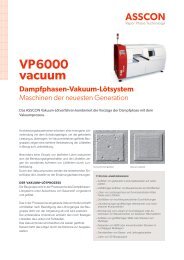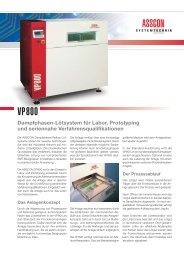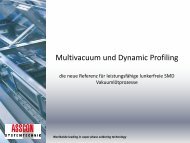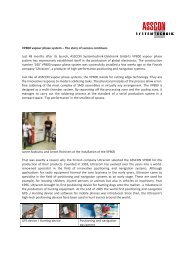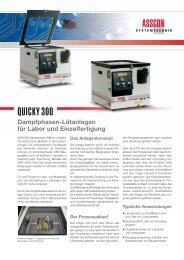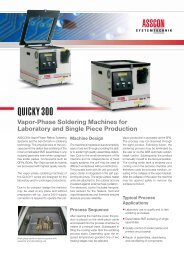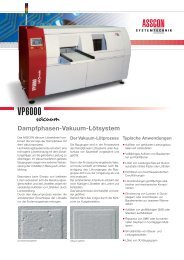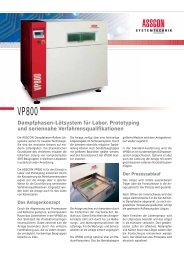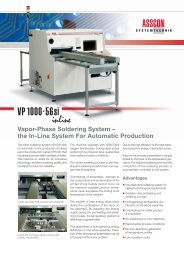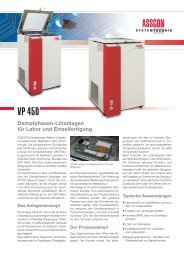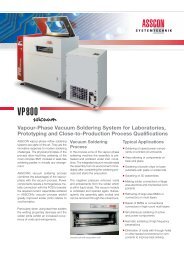Vapor Phase Soldering Technology - ASSCON Systemtechnik
Vapor Phase Soldering Technology - ASSCON Systemtechnik
Vapor Phase Soldering Technology - ASSCON Systemtechnik
Create successful ePaper yourself
Turn your PDF publications into a flip-book with our unique Google optimized e-Paper software.
<strong>Vapor</strong> <strong>Phase</strong> <strong>Soldering</strong> <strong>Technology</strong><br />
Secure Lead-Free<br />
Processes<br />
Due to the switch to lead-free manufacturers are faced with multiple new challenges. Simple processing, successful<br />
soldering for various products, high quality and user-friendliness are the basic requirements that current soldering<br />
systems have to provide. <strong>Vapor</strong> phase soldering meets these demands. However, individual systems vary greatly<br />
when looking at important details.<br />
By Claus Zabel and Uwe Filor, <strong>ASSCON</strong> GmbH<br />
<strong>ASSCON</strong>’s vapor phase soldering systems<br />
feature cutting edge technology with their<br />
variable temperature gradient control in<br />
saturated vapor. These systems provide<br />
process reliability and repeatability.<br />
<strong>Vapor</strong> phase soldering was developed by<br />
Western Electric, Princeton, in the beginning<br />
of the Seventies [1]. Those systems were<br />
based on the two-phase-technology. Due to<br />
high loss of medium a secondary medium<br />
(often CFC) was initiated over the primary<br />
vapor layer. The ban of CFC around 1990 led<br />
to the end of these 2-phase-systems and<br />
caused temporary success of infrared<br />
soldering. However the disadvantages of the<br />
infrared technology, such as different warmup<br />
time of components with varying heat<br />
requirements, soon caused this technology to<br />
reach its limits [2].<br />
Convection soldering took its place and<br />
became the soldering technology of choice for<br />
industrial manufacturing for many years. The<br />
past years have seen increasingly complex<br />
assemblies (e.g. layout, differences in mass)<br />
which pose challenges to the soldering<br />
technology that are becoming more and more<br />
difficult for convection soldering to overcome<br />
(Image 1). <strong>Vapor</strong> phase soldering was<br />
introduced once again. Newly developed<br />
single-phase system concepts now provide<br />
the solutions needed for lead-free soldering<br />
due to the higher soldering temperatures of<br />
this process.<br />
Image 1 Comparison temperature gradient vapor<br />
phase and convection<br />
<strong>Vapor</strong> phase soldering has since undergone<br />
essential developments. The result is the<br />
current technology – soldering under<br />
saturated vapor with variable control of the<br />
temperature gradient.<br />
<strong>Vapor</strong> phase soldering without<br />
controlled thermal output<br />
The first simple design generated a<br />
homogenous vapor layer of saturated vapor.<br />
Even with assemblies of very high mass this<br />
uncontrolled vapor production caused<br />
problematically high initial gradients [3]. To<br />
decrease this disadvantage pre-heat was<br />
generated via infrared heat radiators.<br />
However, this leads to oxidization of metallic<br />
components. Then as now this critical fact<br />
has to be avoided. One method was to<br />
conduct pre-heating by briefly dipping the<br />
product in the upper saturated vapor layer [4].<br />
Compact<br />
How can we successfully eliminate the<br />
disadvantages of early condensation<br />
systems, of soldering with unsaturated<br />
vapor and of the injection method? <strong>Vapor</strong><br />
phase soldering systems with variable<br />
temperature gradient control in<br />
saturated vapor prevent oxidization. In<br />
addition, precise medium temperature<br />
settings eliminate overheating of the<br />
product. Variable temperature gradient<br />
control provides optimum pre-heat and<br />
soldering for any product.<br />
The appropriate dipping depth needs to be<br />
determined for every product. If the product is<br />
dipped too deep, it will be heated to quickly<br />
and if it is not dipped deep enough preheating<br />
is not sufficient. And there is no<br />
satisfactory answer for the correct dipping<br />
height for simultaneous soldering of different<br />
assembly types. Trials to solve these process<br />
uncertainties by repeated dipping at low<br />
height did not prove satisfactory.<br />
Consequently this early system technology<br />
was not considered as fully developed, leaving<br />
room for significant improvements 5].<br />
Intermediate Stage: Injection method<br />
Initial experiments during the 90ies to<br />
eliminate the shortcomings of early vapor<br />
phase systems lead to the injection method.<br />
This method is based on a patent by Prof.<br />
Rahn [6], and used in the first modern<br />
soldering systems [7]. A predetermined
amount of medium is dispensed onto a<br />
heating plate and then abruptly vaporized to<br />
pre-heat the product. The peak zone is<br />
reached by a subsequent main injection.<br />
Excess medium is exhausted after the<br />
soldering process. With this injection method<br />
multiple parameters need to be adjusted,<br />
such as volume of medium, injection and<br />
soldering time, heating plate temperature and<br />
medium temperature. In addition the required<br />
vapor overheating reintroduces one of the<br />
critical disadvantages of convection<br />
soldering into the process - oxidization. And<br />
besides such process related problems, these<br />
systems require significantly higher operation<br />
and maintenance cost.<br />
Controlled Temperature Gradient in<br />
Saturated <strong>Vapor</strong><br />
In the late Nineties injection soldering was<br />
replaced by systems with variable temperature<br />
gradient control. Contrary to the injection<br />
method this technology employs saturated<br />
vapor and combines the important benefits of<br />
vapor phase soldering to provide a stable<br />
and repeatable soldering process.<br />
This process zone is located directly above the<br />
medium container. The medium is heated by<br />
heating plates and generates a saturated<br />
vapor layer directly above the medium fluid.<br />
As the vapor is heavier than air it cannot<br />
elude up in the system. When the product<br />
enters the vapor zone the saturated vapor<br />
layer collapses. The vapor condenses across<br />
the entire product surface; immediately forming<br />
a closed film of fluid around the product.<br />
Contrary to older vapor phase systems the<br />
system controls prevent sudden exposure of<br />
the product to too much energy. Surface<br />
tension of the fluid film and its capillary forces<br />
displace any air from the product. A safety<br />
layer is formed that ensures completely airfree<br />
soldering. After leaving the vapor zone<br />
this fluid film evaporates completely, leaving<br />
no residues on the product.<br />
The saturated vapor layer lies directly<br />
around the fluid film. By introducing an<br />
energy amount corresponding to the required<br />
temperature gradient via heating elements, an<br />
amount of saturated vapor is generated<br />
equivalent to this energy. This specified<br />
amount of vapor now condenses into the<br />
fluid film and emits a precisely defined<br />
amount of energy into the fluid film during<br />
condensation. Its energy concentration<br />
increases accordingly as does the temperature<br />
of the product enclosed by the fluid film.<br />
Following the laws of physics the energy<br />
introduced into the fluid film is distributed<br />
evenly across the entire product (Image 2).<br />
Image 2 Energy flow in a vapor phase<br />
This ensures continuous and homogenous<br />
heating of the entire product. The process<br />
continues until the temperature of the product<br />
equals that of the vapor. When the<br />
temperature balance is achieved<br />
condensation stops automatically.<br />
This concept therefore allows for precise<br />
temperature control of the product by accurately<br />
controlling the energy supply (Image 3). Unlike<br />
the injection method, when soldering in<br />
saturated vapor the vapor temperature<br />
cannot exceed the temperature of ebullition<br />
of the medium. This physically eliminates the<br />
possibility of overheating an assembly.<br />
Image 3 Example: Variable temperature gradient<br />
In addition the vertical structure of systems<br />
working with saturated vapor allows the<br />
operator to identify the end of the soldering<br />
process at all times; irrespectively of the<br />
specific product. The soldering process can<br />
be finished as early as possible. Therefore<br />
an assembly can never remain above liquidus<br />
too long. Contrary to horizontal systems those<br />
designed vertically eliminate the need for<br />
elaborate pumping actions and mechanical<br />
methods for vapor-tight closing and opening<br />
of the process chambers, and therefore do<br />
not cause a noteworthy increase in cycle<br />
time.<br />
As the vapor layer is heavier than air, a<br />
vertical construction also provides for a well-<br />
defined vapor layer, ensuring process stability.<br />
In order to avoid turbulences when dipping<br />
the product into the vapor layer, special care<br />
was taken when designing the control<br />
system. The possibility of choosing any userdefined<br />
temperature gradient setting<br />
provides optimum pre-heating of the product.<br />
Heat transfer fluid Galden®<br />
<strong>ASSCON</strong> recommends for all its vapour<br />
phase soldering systems the Galden fluids.<br />
These fluids are the ideal medium for the<br />
vapor phase soldering process.<br />
The vapor density of Galden fluids is much<br />
higher than that of air and therefore these<br />
fluids guarantee that the complete<br />
preheating and soldering process takes<br />
place in an inert atmosphere. Galden fluids<br />
evaporate quickly from the hot surface<br />
resulting in rapid, residue free drying of the<br />
parts. Galden fluids exhibit high chemical<br />
and thermal stability.<br />
With the increasing use of vapor phase<br />
soldering in production environments,<br />
greater emphasis is being placed on the<br />
nature of the primary fluid selected with<br />
respect to safety, consumption, cost–<br />
effectiveness, temperature selection and<br />
stability, and system compatibility. These<br />
parameters are to some extent linked to the<br />
type and choice of vapor phase machine<br />
but are also governed by the physical<br />
properties of the selected fluids. The<br />
specific properties of Galden fluids make<br />
them particularly suitable for use in vapor<br />
phase heating applications.<br />
Conclusion<br />
<strong>ASSCON</strong>’s vapor phase soldering systems<br />
based on newest technologies (Image 4) have<br />
eliminated the disadvantages inherent to early<br />
condensation systems, soldering with<br />
unsaturated vapor and injection systems.<br />
Image 4 <strong>ASSCON</strong> VP 2000 inline
By employing saturated vapor not only for the<br />
heating but also the pre-heating phase, any<br />
risk of oxidization is eliminated. In addition,<br />
precise medium temperature settings<br />
eliminate overheating of the product in any<br />
stage of the soldering process. Variable<br />
temperature gradient control provides<br />
optimum pre-heat and soldering for any<br />
product. The intelligent, but mechanically<br />
simple vertical structure of today’s saturated<br />
vapor soldering systems allows for automatic<br />
identification of the end of the soldering<br />
process.<br />
And finally one of the most important<br />
benefits: As almost all other process<br />
parameters remain constant when soldering<br />
in saturated vapor, the only parameter an<br />
operator needs to set is the required<br />
temperature gradient. The technology does<br />
not require setting multiple parameters as is<br />
necessary when soldering by injection or<br />
with unsaturated vapor. Therefore saturated<br />
vapor soldering with variable temperature<br />
gradient adjustment achieves maximum<br />
process stability and repeatability – factors<br />
that are especially important when<br />
considering today’s switch to lead-free<br />
manufacturing.<br />
Literature<br />
[1] Deutsches Patentamt Auslegungs-<br />
schrift 24 42 180; AZ: P 24 42 180.5-24<br />
[2] R. J. Klein Wassink, Weichlöten in der<br />
Elektronik, 2. Aufl. 1991, Kap.10.5.3, S.596.<br />
[3] W. Leider, Dampfphasenlöten, 2002,<br />
Kap. 7.1,S.43.<br />
[4] FSL Deutschland GmbH, MRT Vapourphase-System<br />
MRT, Dieburg 1992.<br />
[5] Elektronik, 2. Aufl. 1991, Kap.10.5.3,<br />
S.596.<br />
[6] Deutsches Patentamt, Patent Nr.<br />
DE3873321 T2.<br />
[7] <strong>ASSCON</strong>, VP2000-2-2/9<br />
Contact<br />
<strong>ASSCON</strong><br />
<strong>Systemtechnik</strong>-Elektronik GmbH<br />
Messerschmittring 35<br />
D- 86343 Koenigsbrunn<br />
Fon: +49-8231-95991-0<br />
Fax: +49-8231-95991-90<br />
www.asscon.de<br />
erschienen : epp-europe 11/2007



